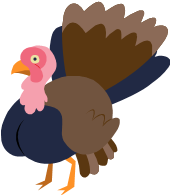Posted by: Kim_Hamilton on 04/02/2009 01:32 PM
Updated by: Kim_Hamilton on 04/02/2009 01:32 PM
Expires: 01/01/2014 12:00 AM
:

Wild Turkeys in Oak Woodlands~by Ken Churches
Traditional feasts often center on domestic turkeys served in a grand fashion. The domestic bird, raised in large flocks, is quite different than its wild counterpart. Domestic turkeys have a reputation of being less than brilliant, docile, slow moving creatures. The wild bird is the complete opposite of the culinary breed....

Keen eyesight, quick of wing and foot, agile, stately, regal are all adjectives that have been used by admirers to describe the bird that Ben Franklin once suggested as the national symbol. Once widespread and common, the wild turkey numbers plummeted in the late 19th century and was extirpated from much of its former range. However, through the work of many conservationists, the bird can be viewed today as a sterling example of restorationists efforts.
Introduced into California in 1877, the wild turkey has spread throughout many portions of the state. Two sub-species have been introduced. The most common, the Rio Grande turkey is found mostly in deciduous riparian oak and conifer-oak woodlands. The other sub-species, Merriam's turkeys, are more often found in higher elevations in predominately conifer-black oak habitats.
Their feeding habits are varied. Turkeys readily eat seeds, berries, leaves, mollusks, buds, acorns, pine nuts, and arthropods. A hen tending a brood will often bring her young to grassy opening during the summer to feed. The young are dependent on grasshoppers and other insects during the summer months for protein and these openings are relied upon for foraging.
Turkeys are diurnal and active throughout the year. They roost above ground usually in large oaks, ponderosa, Jeffrey, or foot-hill pine trees in sheltered, mixed aged stands of foothill oak-conifer habitats. Their dependence on free water regulates them to roost relatively near a permanent source.
Turkeys are ground nesters. A female will lay between 8-15 buffy, spotted eggs in a shallow nest lined with grass and leaves concealed in thick grass or woody vegetation in or near a forest clearing. Within a few days of hatching the young are able to fly and soon begin roosting in trees to avoid predation. Roost trees are a critical component of the habitat if turkeys are to be successful in an area.
Turkeys are still be expanding their range in California since not all suitable habitat is considered occupied. They are capable of living near humans and many people actively attract turkeys by supplementing their diets with chicken scratch and other poultry feeds. The sight of a large tom strutting and calling during the spring courtship is spectacular sight that many people who are fortunate enough to have witnessed often recite and share.
This article adapted from Cooperative State Research, Education and Extension Service, USDA. Please contact Ken Churches at cdcalaveras@ucdavis.edu or (209) 754-6475 with your agricultural questions. To speak with a Certified Master Gardener: Calaveras (209) 754-2880, Tuolumne (209) 533-5696, Amador (209) 223-6837, El Dorado (530) 621-5543.
|

